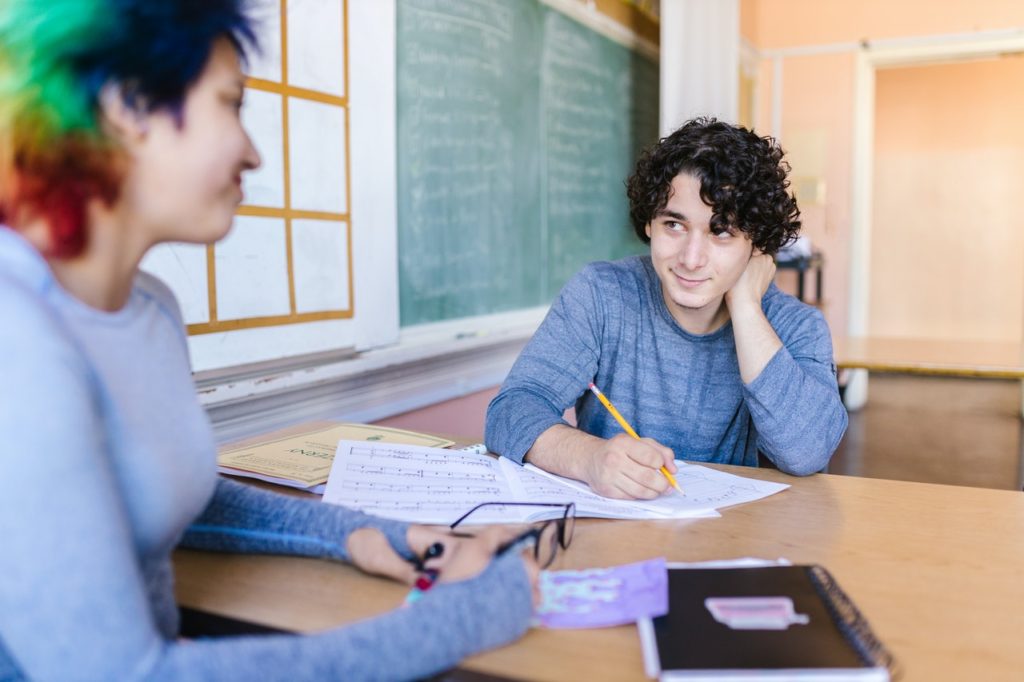Table of Contents
Every class has at least one student who is quite shy and often doesn’t participate in class activities. While they often aren’t struggling in all areas of school, quiet or shy students find it very difficult to do any activities where there is attention on them making it very hard for their voices to be heard in class.
While not everyone has to be a class clown and ham it up in the spotlight, it is also not good practice for teachers to let quiet students simply not participate and not challenge themselves in their areas of weakness. To encourage shy students, teachers need to push them out of their comfort zone but not so far that they dread coming to class.
Do Shy Students Really Need to Speak in Class?
Shy students do not need to speak all the time or become extroverts, but they need to be able to communicate their needs, collaborate with others, and have healthy relationships. Teachers can help shy students develop themselves to be more dynamic in a safe environment so that when they are pushed into difficult dilemmas later life, they will have the tools to speak confidently and solve their issues. If shy students are left alone without help, they can often bottle things up, letting their problems become even larger than if they had been able to verbalize their issues or questions earlier.
While many best practice guides will suggest just letting quiet students never talk. While this may make them more comfortable in the moment, it will limit their opportunities in the future. Being able to express an opinion in front of a group of peers, discuss important topics openly, and successfully interview are important skills for all students to practice. Shy and quiet students have so much to offer the world, but there won’t always be opportunities for them to simply write their thoughts down.
Just because a student struggles with something doesn’t mean they should be allowed to skip it. It is a teacher’s job to challenge their students and help them develop their strengths as well as shore up their weaknesses. Sometimes students may suggest that they will simply choose a career where they can utilize their quiet nature, but even quiet careers require interviews. In addition to this, most students have no idea what they will be doing in the future, and many an introvert has found themselves in careers where they need to speak up, sometimes even to groups.
There are many introverted teachers who started their lives as quiet and shy students. Encouraging shy students to try things they aren’t comfortable with must be done with care and support, but doing so will open more doors in their futures and help them not be held back by a lack of confidence. Just as energetic and loud students must be taught to manage their energy and keep their volume appropriate, quiet students also need guidance in developing ways to manage their reserved nature, to not be antisocial, and speak up in a clear and audible voice.
While not traditionally labeled as a learning difficulty, being too shy or quiet can absolutely hinder a student’s ability to learn. It can also often be accompanied by other conditions such as severe anxiety or other undiagnosed learning difficulties such as ASDs. These hidden conditions often remain unidentified due to the lack of interaction the child has with peers and the teacher. (Nyborg et al.)
Identifying Shy Students in the Classroom

Shy students are often described by their teachers as…
- Unable to use a loud clear voice.
- Preferring the back of the classroom to avoid attention.
- Not participating in group activities.
- Not working well with students that they don’t already know well.
How to Encourage Shy Students to Participate
1: Take it slow with interventions to not scare shy students off.
It is absolutely critical that teachers take it slow when working with students who are shy. Shy students are often sensitive and require a closer relationship before they will begin to trust a new adult. When a teacher identifies a student who seems to never participate or who doesn’t answer when called upon, they shouldn’t push right then and there to see the change they would like to see.
It might sound good to set expectations clearly from the beginning of the school year and while rules do need to be followed by all, not everyone will be fully engaged and participating on day one. Instead, the teacher should focus on finding times to reach out and get to know the student one on one during independent work time.
Some students may be so reserved that even one on one interactions with the teacher make them uncomfortable, and teachers shouldn’t take this personally. It may feel and actually just be rude for the student to not respond when spoken to, but in the long term, it really is best to just let it go and have a talk later on in private about how it made the teacher feel and how the student could respond more appropriately. Teachers should make suggestions that are quick and easy to say rather than requiring full sentences.
2: Develop a relationship first using nonverbal communication.
In order to encourage shy students to speak up more, communicate their needs, and develop a trusting relationship with the teacher, students can be taught little signs or gestures to subtlety communicate a need to the teacher. Raising crossed fingers to signal needing to go to the bathroom and putting on a provided little bracelet to signal that they have a question or need help with something are great basics to start with.
Teachers and students can work together to develop more signals as the year goes on. Giving students an inconspicuous way to communicate with the teacher will not only ensure the students needs are being met, but also strengthen the relationship and rapport between teacher and student. This will make future interventions more likely to succeed due to the increased trust the student will have developed.
3: Start with reading before class discussions.
One of the first steps a teacher can take to help get a shy student more confident in hearing their voice in class is having them read some text. Rather than having to think up a response on the spot, reading only requires the student to say what is right in front of them. This is a lot less stressful than having to come up with something that sounds good themselves.
Another way to make this easier is by having all students read one sentence or paragraph of the text in order. Rather than the shy student feeling like they’re having to read while no one else is, heightening their nerves, when everyone is reading one after the other, it helps them feel like they are blending in by just reading their part quickly and moving on.
Because there is an order, they can be prepared for their part and look it over to feel more prepared. Rather than being called on popcorn style and feeling shocked, increasing their nervous response, having an order lets students know what is coming and when.
Many times it will actually make the student feel more out of place if they don’t read their part and there is a conspicuous gap where they don’t read and their peers notice or comment that they didn’t get a turn. Because of this, it can be more comfortable to just read and because of that, if this is done regularly, they will become more accustomed to speaking out aloud in class and can be challenged more in the future to take the next steps to have their voices heard in multiple contexts.
4: Utilize friendships to encourage shy students to participate.
Many shy students find it very difficult to work in pairs or groups, and this can be bad for the shy student as well as their partner or partners. Because of this, especially at the beginning of the year, it is best to try to pair the shy student with one or two friends or people they feel a bit more comfortable with. The teacher can ask the student to identify a few people they feel most comfortable with and the teacher can try to put them together when appropriate.
While it is good to let them work with friends to keep them from feeling overwhelmed, eventually, shy students need to learn to work with all of their classmates as that is what will prepare them best for the diverse world post graduation. In order to encourage shy students, they can be paired with their friends in the beginning of the year to help them get accustomed to the classroom and gain confidence.
Later on in the year, they should be pushed to work with new partners to increase their social skills and help them work with different types of people. In the post graduation world, people have to interact and work with all sorts of different types of individuals from coworkers to cashiers. Shy students need to be prepared to have successful and respectful interactions even with people that are a bit higher energy than themselves.
5: Ensure they have a safe space to retreat to.

At the end of the day, shy students may still have bad days and it is important that they have somewhere they feel safe as well as a person they feel safe with. It can really be beneficial to let shier students pick their seats when possible or be assigned a nice quiet seat in the back.
These quiet and shy students are rarely the students that teachers need to keep a close eye on or the type to sit in the back and not pay attention. If the quieter students who are going to pay attention anyways feel more comfortable in the back where there are fewer eyes pointed in their direction, that isn’t a huge effort, but might make every day feel significantly more comfortable for the student.
While a teacher may do everything in their power to try and have a safe classroom for, build a relationship with and encourage shy students, there may be some students who still do not open up to them or still hide part of their problems. In these cases, it is important that the teacher make sure that there is some other adult in the student’s life who they do feel more comfortable opening up to.
Each student is different and each teacher will connect with different students. It is not a negative reflection of a teacher if they just don’t click with a certain student to develop that deepest rapport, but when a student has no one and is totally isolated in school, it is important that teachers reach out to the school counselor to just flag the student as someone who might benefit from having someone to talk to.
Conclusion
While many people may consider being very and silent during class as just another learning style to be respected, extremes of any kind can lead to more difficulties for students in their future. Just as a student who has too much energy and talks too much can be a problem that needs to be addressed, students who have trouble talking or interacting at all are equally in need of intervention.
The teacher can’t force changes, but they can do their best to ensure their classroom and school are encouraging shy students to challenge themselves where they feel safe so that they can graduate boldly and continue on to be successful in any future they choose.
Want more like this? Make Lab to Class a part of your weekly professional development schedule by subscribing to updates below.
References
Nyborg, Geir et al. “Teachers’ Strategies For Enhancing Shy Children’s Engagement In Oral Activities: Necessary, But Insufficient?”. International Journal Of Inclusive Education, 2020, pp. 1-16. Informa UK Limited, https://doi.org/10.1080/13603116.2020.1711538. Accessed 10 Feb 2022.



